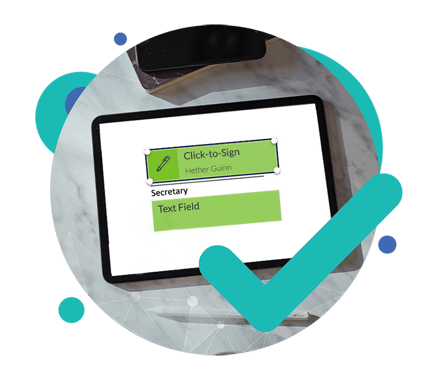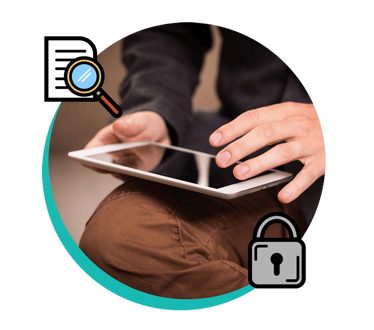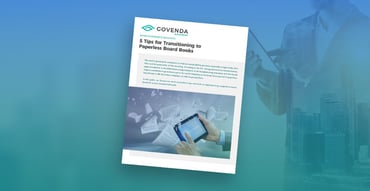A Sign of the Times: Enhancing Board Governance with eSignatures
Corporate governance and boards of directors are increasingly becoming hyperconnected due to on-demand communication and the use of collaborative technology. Electronic signatures (eSignatures) are growing in popularity for a variety of reasons and making business and corporate governance approvals easier and intuitive. Federal law has recognized the legality of eSignatures for more than a decade with the approval of the E-Sign Act of 2000. The E-Sign Act allows parties
 to form valid written contracts through electronic exchanges and signatures. According to the New York Law Journal, “The act provides that ‘unless specifically provided otherwise by law, an electronic signature may be used…in lieu of a signature affixed by hand.’” The ESIGN Act has made it possible to innovate the signing of contracts and approvals for businesses. A Forrester Research survey also found that documents with eSignatures reduced the error rate by 80% and improved productivity by as much as 85%. Today, eSignatures are becoming a mainstream practice among businesses and corporate governance worldwide because they rapidly move business forward and provide a high level of security.
to form valid written contracts through electronic exchanges and signatures. According to the New York Law Journal, “The act provides that ‘unless specifically provided otherwise by law, an electronic signature may be used…in lieu of a signature affixed by hand.’” The ESIGN Act has made it possible to innovate the signing of contracts and approvals for businesses. A Forrester Research survey also found that documents with eSignatures reduced the error rate by 80% and improved productivity by as much as 85%. Today, eSignatures are becoming a mainstream practice among businesses and corporate governance worldwide because they rapidly move business forward and provide a high level of security.
What are eSignatures?
It’s common to hear the terms eSignature and digital signature used interchangeably. However, these two terms represent different concepts. Each of these concepts embodies a distinct set of features and functions. Digital signatures refer to the encryption technology used for electronic signatures. Digital Signatures are based on public and private encryption keys and cryptographic algorithms. They allow for the verification and authentication of a signed record. Thus, digital signatures are used for securing an eSignature.
 Electronic signatures are legally binding like their paper and ink equivalent. They capture a person’s intent to be legally bound to an agreement or contract. “The objective of an electronic signature is to quickly authenticate a document with a uniquely identifiable mark that doesn’t require the use of paper and pen,” says Inc. Magazine. “…Electronic signatures are now widely used in private affairs, legal dealings, business transactions, and even as part of official government documents.”
Electronic signatures are legally binding like their paper and ink equivalent. They capture a person’s intent to be legally bound to an agreement or contract. “The objective of an electronic signature is to quickly authenticate a document with a uniquely identifiable mark that doesn’t require the use of paper and pen,” says Inc. Magazine. “…Electronic signatures are now widely used in private affairs, legal dealings, business transactions, and even as part of official government documents.”
Medium reports that eSignatures consist of 4 basic components: a means of signing, the authentication of data, authentication of the signatories, and the capture of the signatories/ intent. “E-signature technologies include items such as personal identification numbers (PINs), biometric markers, and other user identification processes,” continues Medium. Esignatures allow for convenience, rapid business turnaround, and security.
Convenient Business Turnaround
The convenience of eSignatures is unmatched in business and corporate governance worldwide. Paper and pen are now disparate practices for signing documents when the ease of eSignatures are available. Even small companies utilize suppliers, engage customers, and communicate with partners in different cities, states, and countries. Geographically dispersed boards of directors need the accessibility of eSignature capabilities. “Electronic signatures allow for remote authentication, which makes it a much more convenient solution than the alternative of mailing and/or printing and scanning,” continues Inc. Magazine. Printing and shipping documents is also a costly endeavor and slow down the turnaround of business. Board directors and executives can now sign approvals from a smartphone, tablet, or web browser wherever they are in the world.
Although documents are regularly transmitted electronically through email or electronic board portals, without eSignature signatories need to print, sign, and return contracts. This undoubtedly slows down business. Esignatures can speed up this process giving business a faster turnaround especially during time-sensitive situations. Because eSignatures are legally binding and accepted as a legal signature of intent, they also are compatible with legal compliance practices.
eSignature Security
One concern regarding eSignatures by executives and boards of directors is often security measures. The data shows that eSignatures are safer and more secure than paper documents. Not only do eSignatures contain a legally binding signature, but they also contain encrypted, traceable information about the signatory, when they signed the document, and the location of the signing. “In fact, these technologies provide an additional level of security and trust to all parties engaged in the transaction,” says Crytomathic. “Furthermore, a digital process allows for real time and automatic monitoring and greatly reduces the chance of fraud and the time taken to detect it.” eSignatures are instantaneous and encrypted for the highest level of security measures.
eSignatures and your Board of Directors
Boards of directors can have peace of mind that implementing eSignatures will streamline board governance. The Association of Corporate Counsel outlines some necessary steps boards of directors can take to adopt an eSignature policy:
-
Obtain consent by signing a contract containing provisions stating that all parties to that contract agree to sign electronically
-
One must always retain an electronic copy of the contract in accordance with the usual departmental practice
-
Retain a copy of the contract’s audit log
-
An unaltered, fully executed complete electronic copy of the contract should be sent to all parties for their reference and archiving
eSignatures Made Easy and Secure with Govenda eSign
Govenda eSign feature is integrated directly into our intuitive and secure platform. From the Govenda platform, administrators can see what documents are awaiting a signature and who has signed the document. They also have the ability to email any users who have not signed for an easy reminder to sign a certain document. Govenda eSign also works with every device including smartphones, tablets, and web browsers so users can sign a document with eSignatures wherever they are in the world.
Govenda eSign takes eSignatures to the next level by allowing users to sign by clicking a checkbox, signing with a signature capture, and clicking to sign with initials. Admins can also require signatories to include the signing date, name, professional title, and company with their signature. If explanation with a signature is needed, admins can require signatories to add additional information in the form of text fields, checkboxes, list items, radio buttons, text areas, and label fields.
The Govenda eSign feature keeps security at the forefront with legal audit trails. Once a document is signed and downloaded, the admin is provided with a permanently embedded legal audit trail that encompasses the time a person signed a document, the IP address of the signer, and the email address of each signer. This audit trail allows the document to become legally binding. Govenda eSign also protects people’s signatures when they sign a document. Documents can’t be modified without detecting the digital signature. Signatures are encrypted using advanced, military-grade digital signature technology that is tamper evident. Our technology visibly invalidates the document if any changes are detected.
Govenda proudly integrates eSignatures into our electronic board portal to help boards of directors securely sign documents from wherever they are. “Counsel who use them not only find them a safe, effective way of doing business, but often, they also remark that they could not imagine returning to paper-based process,” continues the ACC. Govenda eSign is the perfect eSignature feature for important decisions that require sign off by board members outside of normal board meetings. Items like stockholder distributions, equity grants or transfers, and employee benefit adoption are all examples of how your board can use Govenda eSign. Implementing eSignatures in a board of directors best practices is a simple way to not only move to a paperless initiative but streamline board approvals and decisions to enhance business.
Interested in learning more about Govenda eSign? Let’s start a conversation today!
Other posts you might be interested in
View All Posts
eSignature Software: Electronic Signatures Enhance Board Governance
Read More
Implementing Board Reporting Software for Optimal Oversight
Read More
Board of Directors Portal: Scalability That Grows With You
Read MoreSubscribe to email updates
Get updates delivered directly to your inbox.
 Board Management Software for Better Governance
Board Management Software for Better Governance Govenda Brochure
Govenda Brochure